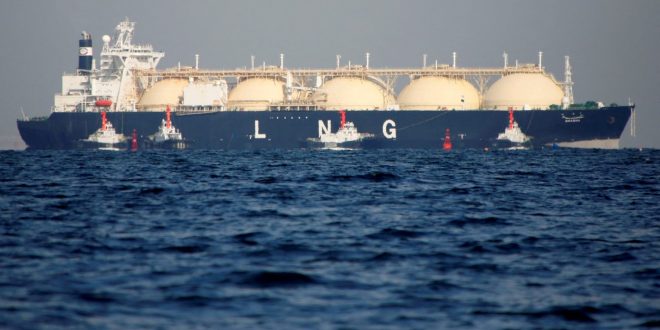In light of Russia’s invasion of Ukraine, many European countries have rushed to secure alternative gas supplies through the development of liquefied natural gas (LNG) import terminals.
This step has sparked some sharp reactions in the climate-change community. A number of observers have raised concerns that, by building new LNG import terminals, Europe would “lock in” its reliance on fossil fuels and jeopardise its climate goals.
However, such worries, though well-intentioned, are generally overblown. New LNG import facilities are neither likely to affect Europe’s long-term dependency on fossil fuels nor have a significant impact on its climate plans.
First, it is wrong to assume that, by developing new LNG receiving infrastructure, European governments are abandoning their carbon neutrality plans. The main reason why these LNG terminals will be built is because there is a clear and urgent need to replace large amounts of Russian gas in Europe.
Continuing to buy gas from a supplier hell-bent on obliterating a sovereign country and that has committed atrocities described as genocide by some is morally wrong and strategically short-sighted.
Meanwhile, there are no indications that governments would be considering scaling down their investments in renewables anytime soon.
Rather, the opposite is the case. Existing evidence suggests that Europe, both on the European Union and the member state level, is planning to turbocharge its push for renewables as part of a broader strategy to end their energy dependence on Russia and to fight climate change.
Second, the development of LNG terminals will not prolong Europe’s dependency on fossil fuels. Regardless of whether or not governments would build new LNG terminals, Europe was and is expected to remain a significant natural gas consumer for many years to come.
In 2020, the EU consumed 401 billion cubic metres (bcm) of natural gas and, according to the International Energy Agency’s most optimistic forecast, its demand for gas could decrease to 315 bcm in 2030 and 57 bcm in 2050.
However, the most optimistic forecast is also the least likely one. Unless there would be any major clean energy breakthroughs over the next 10-15 years (mass rollout of green hydrogen, deep electrification, etc.), it is entirely possible that the EU’s demand for natural gas could still hover in the 100-200 bcm range by mid-century.
Therefore, there is a fairly low risk of having stranded assets when there will be near-guaranteed demand for natural gas at least for a couple more decades in Europe.
Third, renewables can’t fully replace Russian gas. Greater investments in wind and solar energy, biofuels, batteries, green hydrogen and various energy efficiency initiatives can and will erode Europe’s dependency on Russian energy supplies.
As a matter of fact, countries like Denmark and Austria intend to generate 100% of their electricity from renewables by 2030. However, it will take much longer until these clean energy technologies could fully replace natural gas in hard-to-abate sectors.
In the short to medium term, the role of renewables in replacing natural gas in heating and industrial processes is particularly problematic.
Given that grid scale-energy storage technologies are still in their infancy and wind and solar energy are intermittent, it would be very difficult to keep homes warm in colder climates during peak heating season with renewables alone.
Similarly, renewables would also be of little help for heavy industries, like steel, cement and chemicals, where very high temperatures are required.
Granted, all of this does not mean that natural gas is a clean fuel and that we should embrace it unreservedly. It’s still a fossil fuel that, at best, can be seen as a “bridge fuel” to a zero-carbon future. Renewable sources of energy are and will remain our best hope to tackle climate change.
However, considering that Europe’s reliance on natural gas is here to stay for at least a little longer, in parallel to expanding investments in renewables, it would also make sense to focus on reducing the carbon footprint of the natural gas value chain.
For starters, governments could double down on their efforts to support policies that would reduce methane leakages and other upstream emissions.
Meanwhile, in the midstream segment (i.e. the shipping of LNG), it would be possible to reduce carbon emissions through carbon offsets and environmental projects.
Perhaps most crucially, the greatest carbon savings can be done in the downstream end of the value chain through the deployment of carbon capture and utilisation (CCU) technologies at gas-fired plants.
If installed, CCU equipment could reduce CO2 emissions at smokestacks by 90% or more. In addition, the newly captured CO2 could then be used as a raw material in the manufacturing of numerous chemical products or the production of synthetic fuels.
In the end, there is very little evidence that new LNG infrastructure could derail Europe’s climate goals. LNG import terminals will allow the replacement of Russian piped gas with seaborne supplies from other places, but they will not prolong Europe’s dependence on fossil fuels.
If anything, the current energy crisis and the shift from Russian energy supplies will probably accelerate Europe’s deployment of clean energy sources and, in the long run, aid its decarbonisation efforts.

FILE PHOTO: A liquefied natural gas (LNG) tanker is tugged towards a thermal power station in Futtsu, east of Tokyo, Japan November 13, 2017. REUTERS/Issei Kato/File Photo
 Iran Energy News Oil, Gas, Petrochemical and Energy Field Specialized Channel
Iran Energy News Oil, Gas, Petrochemical and Energy Field Specialized Channel



